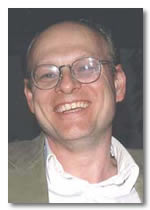| |
 |
|
|
|
L.
H. Eliasson
Visit: April 15 - April 27, 2002
Lectures
Tuesday, April 16, 2-3 PM, MS 6627
Tuesday, April 23, 2-3 PM, MS 6627
Thursday, April 25, 2-3 PM, MS 6627
Colloquium: Thursday, April 18,
4-5 PM, MS 6627.
Title of lectures: KAM (Kolmogorov-Arnold-Moser)
The problem of existence of invariant tori, i.e. quasi-periodic solutions,
for nearly integrable Hamiltonian systems and symplectic maps was posed
by Poincaré in volume II of his ``Méthodes nouvelles de la
mcanique célèste''. This problem involves a delicate mixture
of analytical, algebraic-geometrical and arithmetical difficulties,
and Poincaré himself doubted that it had a positive solution. These
difficulties were only overcome by the development of KAM-theory, due
to Kolmogorov-Arnold-Moser.
One can distinguish three periods in the short history of KAM. The first
one is related to maximal tori and started around 1960 with Arnold's
proof of invariant tori in Hamiltonian systems and Moser's proof of
invariant curves for twist-maps. A second period is related to lower-dimensional
tori. These works developed from 1985 and have found applications
in infinite-dimensional systems. Most recently, since around 1990, there
has been a lot of interest in degenerate system. Such systems,
though non-generic, are important because they occur in many applications,
for example in celestial mechanics. These ideas are also relevant for
non-symplectic dynamical systems.
We shall describe a unified approach to these problems which separates
the difficulties and makes evident that the essential difference between
these problems is of arithmetical nature.
We shall also discuss dynamics and reducibility of linear quasi-periodic
systems. Reducibility is strongly related to existence of invariant
tori for non-linear systems and there has been some interesting progress
in this problem since around 1990. These works have found applications
to one-dimensional Schrödinger operators.
Colloquium Title: Quasi-periodic
skew-products
The dynamics of quasi-periodic linear systems, like the one-dimensional
Schrödinger equation, has been studied for a long time but is still
far from being completely understood. Several interesting results have
been obtained the last ten years using perturbation theory of KAM-type.
They show that this class of systems has a very rich structure where
phenomena like reducibility, ergodicity and non-uniform hyperbolicity
(related to point spectrum of the Schrödinger operator) play
an important role.
Background
L. H. Eliasson works in Hamiltonian dynamics and KAM-theory. He was
a student of Jürgen Moser and passed his thesis in 1984 on a problem
in symplectic geometry. He gave the first proof of existence of (non
hyperbolic) lower-dimensional tori and he gave the first direct proof
of convergence of the Lindstedt series. He has also contributed to the
theory of one-dimensional quasi-periodic Schrödinger operators
and quasi-periodic skew-products.
He received the Salem prize in 1996 and was invited lecturer at ICM
in Berlin 1998. He became professor at KTH (Stockholm) in 1997 and at
University of Paris 7 in 2000.
|

